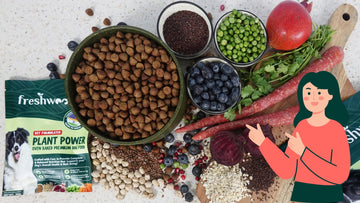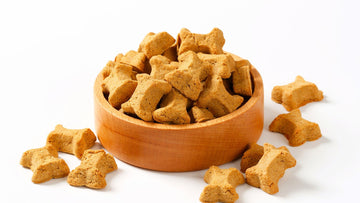Carbohydrates are a group of compounds with a common biochemical structure based on carbon (C), hydrogen (H), and oxygen (O). Carbohydrates enclose sugars, starches, and dietary fibers. The simplest molecules within carbohydrates are sugars (monosaccharides and disaccharides). Longer chains and structures made of those sugars are complex carbohydrates like starches (polysaccharides) and dietary fibers (oligo and polysaccharides). Sugars and starches are called digestible carbohydrates. Carbohydrates play an important role in your dog’s body. Even though carbohydrates are considered a non-essential nutrient and often mistaken as filler in the dog food, it provides highly digestible and readily available energy to the dog.
Carbohydrates can be divided into two parts –
- Digestible carbohydrates:These are the carbohydrates that are digestible and available to provide energy to the cells. It includes starch and sugar.
- non-digestible carbohydrates:These are the one that mostly passes through the intestine without breaking down or being digested. It includes fiber.
What is the purpose of digestible carbohydrates?
Digestible carbohydrates are a direct source of glucose, which is an important source of energy for the body. Glucose is the main source of energy for the brain, the red blood cells, and many tissues in the body. If dietary carbohydrates are not provided as a source of glucose, the body will make glucose from other substrates, such as protein. Consuming carbohydrates in the diet allows the protein to be spared for more important purposes such as growth and maintenance of the body rather than being used for energy production. Otherwise, a fair amount of protein will be used in producing energy and less amount of protein would be left for the growth and maintenance of the body. Another option many can see is, adding more protein to the dog’s diet for energy purposes instead of carbohydrates which simply means keeping your dog on a diet high in meat. But high amount of meat in these diets used as the protein source contains other nutrients as well that should not be fed to dogs in excessive amounts. For example, when a diet is mostly meat it becomes very difficult to maintain a proper calcium-phosphorus ratio. When this ratio is out of balance disruptions in bone growth or kidney damage can occur. Moreover, extra protein is not used efficiently by the body and may impose a metabolic burden on your dog's body. Producing energy from protein is a longer and more effort-intensive process. Well formulated dog foods have an appropriate balance of protein, fat, and carbohydrates to prevent certain health problems from happening.
Fats on the other hand are the slowest form of energy and using fats as a source of energy is a long and complex process too. Fats are used by the body for the absorption of fat-soluble vitamins and synthesizing hormones. Fats are better for longer, slower, lower-intensity activities or during endurance exercise. Fats are less accessible and not suitable as energy source for quick and intense activities. If fed too much fat, the body may also deposit excess fat in blood vessels and within organs, where it can block blood flow and damage organs, often causing serious disorders. “Too much of a good thing” in the diet could be useless or even harmful for healthy individual dogs. It’s all about creating a balance between all the required nutrients in the body. Your dog needs sufficient carbohydrates, protein, and fats in the proper amount to promote a healthy body.
So, if you think that replacing carbohydrates with protein and fats will do the job then you definitely need to rethink it. Carbohydrates are the most preferred source of energy for the body and the brain. The dog’s body will use fats and protein as a source of energy only when there is not enough carbohydrate present in the diet.
What is the purpose of indigestible carbohydrates?
Indigestible carbohydrates or Fibre has several benefits to pets. There are two types of fiber, fermentable and non-fermentable fiber. The fermentable fibers known as prebiotic fibers promote the growth of beneficial intestinal microbiota or good bacteria. These bacteria are actually crucial for optimal health in dogs as well as humans. They play various roles related to weight management, blood sugar control, immunity, brain function, mental health and reduce harmful or bad bacteria colonization. The fermentation products of fiber are the main source of energy for the cells in the large intestine. For this reason, they play an important role in colon health. Non-fermentable fiber promotes regular bowel movements and regulates fecal consistency. If your dog’s diet is deficient in fiber then they may suffer constipation, watery stools and a bad gastrointestinal health. Fiber plays a major role in digestive health; it keeps our dogs healthy by keeping the digestive tract flowing and the dog’s bowel movements soft and regular.
Can dogs digest carbohydrates?
Absolutely, a dog’s body can easily digest carbohydrates and use them in the most effective way. In fact, dogs are able to convert certain carbohydrate sources into glucose that are easily absorbed. Their bodies have elegantly designed to process carbohydrates and reap the benefits from them. Amylase, a group of enzymes that hydrolyze starch (a type of carbohydrate) is released from the pancreas which breaks down starch into disaccharides which are converted into glucose by other enzymes to supply the body with energy.
Choosing between healthy carbohydrates and not-so-healthy carbohydrates
Understanding the true health benefits of carbohydrates for dogs involves looking at the types of foods that fall within this dietary classification. There is a requirement to identify which food is a source of healthy carbohydrates and which one is not.
Healthy Carbohydrates includes some of the healthiest food in the world. Healthy carbs are packed with vitamins, minerals, antioxidants and phytonutrients (plant nutrients, not found in meat) that promote optimum health at the cellular level, including destroying tumor cells and promoting a healthy body, we definitely would not want our canine companions to miss out on their benefits. It includes Cruciferous vegetables, whole fruits, whole grains, green leafy, and other whole vegetables. Viewing these as merely energy-producing foods is like viewing dogs as merely four-legged creatures with fur.
There is so much more to them than that! These vegetables, fruits, and whole grains are a source of a large variety of nutrients and constitute the major part of the diet of people living in “Blue Zones” (Blue Zones are regions of the world where it is claimed, a higher than the usual number people live much longer than average). The same can be applied to dogs as they are physiologically omnivores just like humans and the best example to prove it is Bramble, a blue merle collie, who lived to 25 years of age. Bramble lived in the UK and held the Guinness World Record for being the oldest living dog at the time. What’s the most amazing thing about this story is that Bramble actually lived on a vegan diet of fruits, vegetables, legumes, and whole grains (no meat, eggs, and dairy).
The one thing you would want to avoid is the bad carbohydrate. Processed carbohydrates such as white sugar or table sugar and white flour, sugar-sweetened beverages, white bread, pastries other items made with white flour fall into the unhealthy category. These are the carbohydrates that have had their nutrients stripped away, contain empty calories, and quickly raise blood sugar levels after eating them.
It’s easy to find conflicting opinions about carbohydrates in dog food. Animal nutritionists promote the use of healthy carbohydrates in dog food for their beneficial effects, yet other voices seem to disparage them and regard carbohydrates as unessential. It’s false to conclude that carbohydrates can’t provide value in your dog’s diet, they certainly can. We want to help you make an informed choice for your dog. Let’s go beyond arguments and dig into the science.
Happy Feeding!
References: https://www.fediaf.org/39-prepared-pet-foods/105-carbohydrates-in-dog-and-cat-food.html
https://www.petmd.com/dog/centers/nutrition/evr_dg_dangers_of_high_protein_dog_foods
https://www.ncbi.nlm.nih.gov/pmc/articles/PMC4045293/
https://www.bluezones.com/2020/07/blue-zones-diet-food-secrets-of-the-worlds-longest-lived-people/
Axelsson, Erik, et al. “The Genomic Signature of Dog Domestication Reveals Adaptation to a Starch-Rich Diet.” Nature (March 2013) 495: 360–364
Arendt, M., et al. “Amylase Activity Is Associated with AMY2B Copy Numbers in Dog: Implications for Dog Domestication, Diet and Diabetes.” Animal Genetics (October 2014) 45(5): 716–722.
Semp P.-G. Master’s Thesis. Veterinary University of Vienna; Vienna, Austria: 2014. Vegan Nutrition of Dogs and Cats. [Google Scholar]





